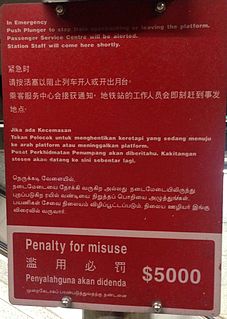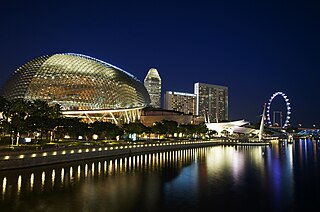
Singapore, officially the Republic of Singapore, is a sovereign island city-state in maritime Southeast Asia. It lies about one degree of latitude north of the equator, off the southern tip of the Malay Peninsula, bordering the Straits of Malacca to the west, the Riau Islands to the south, and the South China Sea to the east. The country's territory is composed of one main island, 63 satellite islands and islets, and one outlying islet, the combined area of which has increased by 25% since the country's independence as a result of extensive land reclamation projects. It has the second greatest population density in the world. The country is home to almost 5.7 million residents, 61% (3.4 million) of whom are Singaporean citizens. There are four official languages of Singapore: English, Malay, Chinese, and Tamil; with English being the lingua franca. Multiracialism is enshrined in the constitution, and continues to shape national policies in education, housing, and politics.
The demographics of Singapore include the population statistics of Singapore such as population density, ethnicity, education level, health of the populace, economic status, religious affiliations and other demographic data of the population.
Singapore English is the set of varieties of the English language native to Singapore. English language spoken in Singapore, of which there are two main forms, are Standard Singapore English and Singapore Colloquial English. English is the first language of the plurality of the population.
Religion in Singapore is characterised by a wide variety of religious beliefs and practices due to its diverse ethnic mix of peoples originating from various countries. This means that Singapore is commonly termed as a "melting pot" of various religious practices originating from different religious denominations around the world. Most practised religious denominations are present in Singapore, with the Inter-Religious Organisation, Singapore (IRO) recognising 10 major religions in the city state. A 2014 analysis by the Pew Research Center found Singapore to be the world's most religiously diverse nation.

Chinese Singaporeans are a local ethnic group in Singapore, defined as Singaporean nationals of full or partial Chinese ancestry. Chinese Singaporeans constituted 76.2% of the Singaporean population, making them the largest ethnic/ancestry group in Singapore.

Indian Singaporeans is a local ethnic group located in Singapore. The group is defined as Singaporeans of Indian or South Asian ancestry, which constitutes 9.0% of the country's citizens, making them the third largest ethnic group in Singapore.

The Singapore National Day Parade is a national ceremony in Singapore that includes a parade on Singapore's National Day on August 9, in commemoration of Singapore's independence as a city-state. It is usually held at the Float @ Marina Bay, various decentralized venues all over Singapore, Padang and the National Stadium.
The Chingay Parade is an annual street parade held in Malaysia and Singapore in celebration with the birthdays of the Chinese deities or the procession of the Goddess of Mercy (Guanyin) as part of the Chinese New Year festivities. The term Chingay itself originated from the Chinese communities of Southeast Asia, which is a phonetic equivalent of both the Chinese words "真艺" (zhēnyì) which means "true art" in the Penang version, and "妆艺," (zhuāngyì) which means "a decorated miniature stage" or float in the Singapore version. PAYM has been an active contributor to chingay in Singapore. Today the parade is celebrated by all communities of both Malaysia and Singapore.

The Singapore National Pledge is an oath of allegiance to the flag of Singapore and the Republic of Singapore. It is commonly recited by Singaporeans in unison at public events, especially in schools, in the Singapore Armed Forces and during the National Day Parade.

The 1964 Singapore Riots refer to a series of communal race-based civil disturbances between the Malays and Chinese in Singapore following its merger with Malaysia in 1963, and were considered to be the "worst and most prolonged in Singapore’s postwar history". The term is also used to refer specifically to two riots on 21 Jul 1964 and 2 Sep 1964, particularly the former, during which 23 people died and 454 others suffered severe injuries.

According to the Constitution of Singapore, the national language of Singapore is Malay, which plays a symbolic role, as Malays are constitutionally recognised as the indigenous peoples of Singapore, and it is the government's duty to protect their language and heritage. “The national language shall be the Malay language and shall be in the Roman script […]” Also according to the constitution, the four commonly used languages of Singapore are English, Chinese, Malay and Tamil, with the lingua franca being English.

The history of the modern state of Singapore dates back to its founding in the early nineteenth century, but evidence suggests that a significant trading settlement existed on the Island of Singapore in the 14th century. At the time, the Kingdom of Singapura was under the rule of Parameswara, who killed the previous ruler before he was expelled by the Majapahit or the Siamese. It then came under the Malacca Sultanate and then the Johor Sultanate. In 1819, Sir Thomas Stamford Raffles negotiated a treaty whereby Johor allowed the British to locate a trading port on the island, leading to the establishment of the British crown colony of Singapore in 1819.

Singapore was one of the 14 states of Malaysia from 1963 to 1965. Malaysia was formed on 16 September 1963 by the merger of the Federation of Malaya with the former British colonies of North Borneo, Sarawak and Singapore. This marked the end of a 144-year British rule in Singapore which began with the founding of modern Singapore by Sir Stamford Raffles in 1819.

Greater Indonesia or Greater Malay, in Indonesian and Malaysian Indonesia Raya or Melayu Raya, was a political concept that sought to bring the so-called Malay race, only part of which were the actual Malays, together by uniting the British territories of Malaya and Borneo with the Dutch East Indies became a large and sovereign nation. It was espoused by students and graduates of Sultan Idris Training College for Malay Teachers in the late 1920s, and individuals from Sumatra and Java including Muhammad Yamin and Sukarno in the 1950s. Indonesia Raya is also the name of the Indonesian national anthem.
The concept of race or ethnicity in contemporary Singapore emerged from the attitudes of the colonial authorities towards race and ethnicity. Today, the Chinese-Malay-Indian-Others (CMIO) model is the dominant organising framework of race in Singapore. Race informs government policies on a variety of issues such as political participation, public housing and education. However, the state's management of race, as well as the relevance of the CMIO model, has been a point of contention amongst some in recent years.

Previously an important landmark, the former National Theatre was built on the slope of Fort Canning Park along River Valley Road in the Museum Planning Area of Singapore. The theatre was officially opened on 8 August 1963 to commemorate Singapore's self-government and was the first and largest national theatre in Singapore back then. It was once the venue for various international performances, universities' convocations and the National Day rallies until it was demolished in August 1986 due to structural reasons and to make way for the nearby construction part of Central Expressway along Clemenceau Avenue.

The culture of Singapore or Singaporean culture has changed greatly over the millennia. Its contemporary modern culture consists of a combination of Asian and European cultures, mainly by Malay, South Asian, East Asian and Eurasian influences. Singapore has been dubbed as a country where "East meets West", "Gateway to Asia" and a "Garden city".

Malayness is the state of being Malay or of embodying Malay characteristics. This may include that which binds and distinguishes the Malay people and forms the basis of their unity and identity. People who call themselves Malay are found in many countries in Southeast Asia, united by a notional shared identity but divided by political boundaries, divergent histories, variant dialects and peculiarities of local experience. While the term 'Malay' is widely used and readily understood in the region, it remains open to varying interpretations due to its varied and fluid characteristics. 'Malay' as an identity, or nationality, is considered as one of the most challenging and perplexing concepts in the multi-ethnic world of Southeast Asia.
In Singapore, language planning is associated with government planning. In this top-down approach, the government influences the acquisition of languages and their respective functions within the speech community through the education system. Language planning aims to facilitate effective communication within the speech community, which can result in a language shift or language assimilation. The goals of language planning are very much dependent on the political and social forces present in Singapore during two distinct periods: Colonisation by the British and the Post-Independence period after 1965.

Singaporeans or Singaporean people refers to citizens or people who identify with the city-state of Singapore. Singapore is a multi-ethnic, multi-cultural and multi-lingual country, and Singaporeans of Chinese, Malay, Indian and Eurasian descent have made up the vast majority of the population since the 19th century.














